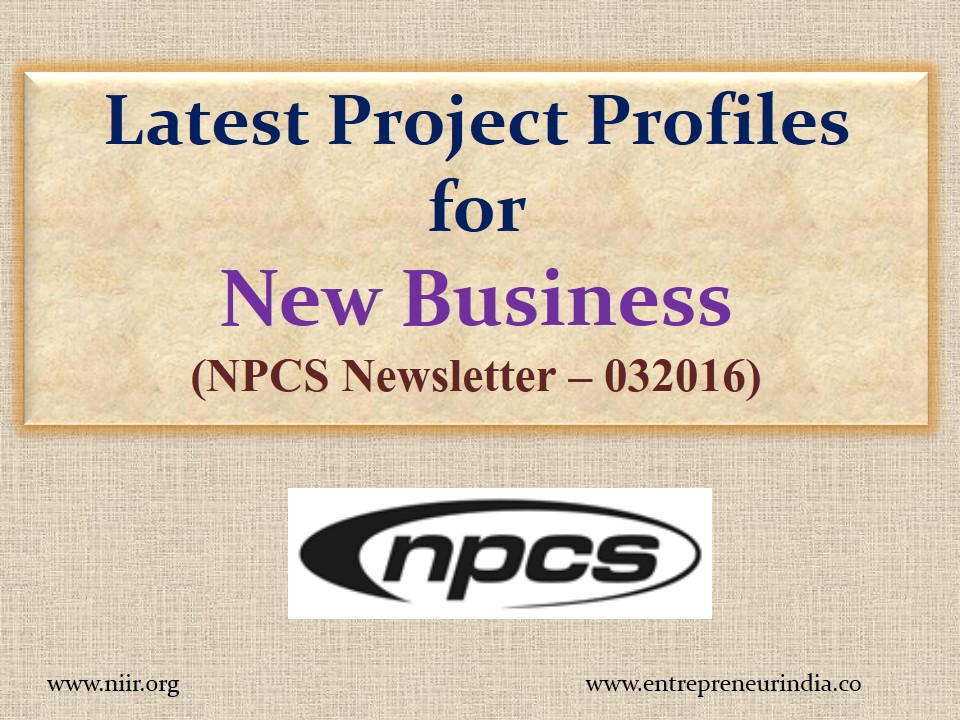
The issue of NPCS March 2016 was released as a valuable guide for entrepreneurs seeking modern and profitable startup ideas. The edition, published by the National Project Consultancy Services, had been designed to introduce readers to innovative industrial and agricultural business opportunities. With the rise of small-scale industries and growing interest in Make in India initiatives, the relevance of such project profiles had been significantly increased.
A wide spectrum of business opportunities had been featured, ranging from food processing to chemical manufacturing. The presented ideas had been structured in a way that aspiring entrepreneurs, SMEs, and investors could easily grasp the required processes, raw materials, technologies, and capital investment needs. Furthermore, each project profile had been meticulously evaluated for market potential and profitability.
Comprehensive Overview of Business Segments
A variety of industries had been covered in NPCS March 2016, making it an ideal reference for readers exploring multiple domains. As many entrepreneurs face difficulties in selecting the right business model, this issue had been curated to provide in-depth feasibility reports and sector-specific insights.
See Also : Beer & Wine Industry
Food Processing and Agro-Based Industries
In this edition, special focus had been placed on agro-processing and food value-addition projects. Because food processing remains one of the fastest-growing sectors in India, several ideas had been included to encourage rural and urban participation.
Some of the highlighted projects included:
-
Mango pulp and canned fruit production
-
Ready-to-eat (RTE) snacks and meal kits
-
Fruit juice bottling plants
-
Rice bran oil extraction
-
Dehydrated onion and garlic flakes
Owing to the rising demand for convenience foods and export potential, these ventures had been regarded as low-risk and scalable. Moreover, by-products and processing residues had been suggested for secondary income opportunities.
Chemical and Allied Industries
Projects related to chemicals had been prominently outlined due to their essential role in agriculture, manufacturing, and construction. Given the versatility of chemical-based businesses, options had been provided to suit both micro-scale and large-scale operations.
Among the profiles covered:
-
Manufacturing of adhesives and synthetic resins
-
Phenolic resins and epoxy formulation
-
Paints, varnishes, and industrial coatings
-
Sulphuric acid and derivatives production
Because safety standards and compliance had been emphasized, a dedicated section on environmental regulations and quality certifications had also been included.
Plastic and Polymer-Based Industries
This edition had also examined business opportunities in the plastic processing segment. Owing to India’s large packaging and consumer goods market, the demand for polymer-based products had remained high.
Feasible projects in this category had included:
-
PET preform manufacturing
-
Plastic recycling and reprocessing
-
Injection-moulded products
-
Disposable plastic cups, plates, and containers
In view of recent environmental policies, projects involving biodegradable plastics and sustainable packaging solutions had been introduced as viable long-term investments.
Herbal and Cosmetic Product Manufacturing
An emerging business segment explored in NPCS March 2016 had been herbal and personal care products. With consumers shifting toward chemical-free alternatives, the edition had offered detailed project guides for:
-
Herbal shampoos and hair oils
-
Ayurvedic massage oils and balms
-
Herbal toothpaste and mouthwash
-
Natural cosmetics and skincare creams
Raw materials, formulation techniques, and packaging details had been described. Since herbal formulations require less capital and are well-suited for cottage industries, entrepreneurs had been encouraged to explore this niche.
Livestock and Dairy Projects
Animal husbandry and dairy-based projects had also been emphasized due to their consistent market demand and government support. Detailed business models had been outlined for:
-
Mini dairy units for milk, curd, and paneer
-
Ghee and butter manufacturing
-
Poultry farming and egg production
-
Fodder cultivation and feed processing
These ventures had been found particularly suitable for rural entrepreneurs. Furthermore, low capital investment and fast returns had made them attractive options for new entrants.
Why Entrepreneurs Had Trusted NPCS March 2016
The reliability of NPCS March 2016 had been rooted in the expertise of National Project Consultancy Services. Every project profile had been supported by:
-
Estimated plant capacity and setup cost
-
Raw material requirements and sourcing
-
Manufacturing process flowcharts
-
Quality standards and certifications
-
Market demand analysis and financial projections
Not only had these details simplified decision-making for investors, but they had also allowed bankable project reports to be prepared quickly. Consequently, easier access to funding and subsidies had been made possible.
Additionally, transition support services, including technical consultancy, supplier database, and marketing tie-ups, had been recommended for implementation.
Emphasis on Technology and Automation
To address industrial competitiveness, the issue had placed a strong focus on integrating modern technologies. For instance:
-
Retort pouch technology had been introduced for RTE food packaging
-
Vacuum and freeze-drying systems had been promoted for fruit dehydration
-
PLC-based control systems had been suggested for chemical manufacturing
-
Blow moulding and injection moulding machines had been evaluated for plastic units
By embracing automation and precision control, project feasibility and quality assurance had been greatly improved. As a result, units could meet international standards and gain access to export markets.
Investment Scale and Risk Diversification
The edition had strategically included projects with varying levels of investment. From small-scale businesses under ?25 lakhs to industrial plants exceeding ?5 crores, opportunities had been made available for all investor categories.
Moreover, by offering suggestions for raw material substitution, seasonal alternatives, and product diversification, the risk of business failure had been significantly reduced. Projects in multiple regions and climate zones had also been showcased to suit location-specific entrepreneurship.
Government Support and Financial Incentives
Given India’s startup-friendly environment in 2016, NPCS March 2016 had highlighted government schemes and subsidies. Some of the key initiatives that had been linked with the project ideas included:
-
PMEGP (Prime Minister’s Employment Generation Programme)
-
MUDRA loans for micro-enterprises
-
Startup India tax exemptions
-
MSME credit-linked subsidy schemes
Furthermore, special attention had been paid to women entrepreneurs and SC/ST beneficiaries by recommending projects that aligned with inclusive development policies.
How to Choose the Right Project Profile
Although the issue had presented over 40 profitable projects, selecting the right one had required strategic thinking. Therefore, guidelines had been provided to readers on:
-
Assessing market demand in the local region
-
Aligning the business idea with personal skills or technical background
-
Evaluating raw material availability and infrastructure
-
Calculating realistic ROI and breakeven periods
-
Considering scalability and future expansion
By following these steps, entrepreneurs had been advised to create a shortlist of 3–5 ideas before final selection.
Value Addition and Branding
It had also been recommended that entrepreneurs focus on value addition and branding from day one. Even basic products such as flour or soap could generate high margins if packaged attractively and marketed under a unique brand name.
Moreover, digital marketing and e-commerce had been identified as powerful tools for reaching customers. Entrepreneurs had been encouraged to adopt D2C (direct-to-consumer) models alongside traditional retail.
Customization and Consulting
Lastly, NPCS had offered custom project report preparation and detailed feasibility consulting. Since no two businesses operate under the same circumstances, personalized strategies had been emphasized. Accordingly, technical support, sourcing assistance, and plant setup services had been extended to interested clients.
Industry-Specific Experts
The team behind NPCS March 2016 had included experienced consultants, engineers, and economists. Therefore, the guidance offered had gone beyond academic theory and included practical solutions to on-ground problems. Case studies and success stories had further inspired readers to take action.
See Also : Carbon Fiber & Composites
Conclusion
In summary, NPCS March 2016 had emerged as a well-researched and practical guide for entrepreneurs. From food processing and chemicals to herbal and plastic-based industries, a wide array of profitable business ideas had been outlined. Furthermore, by incorporating market research, process flow, investment guidance, and regulatory support, the edition had enabled thousands of readers to confidently launch new ventures. As India continues to promote startup culture and self-reliance, such project profiles remain invaluable tools for turning ideas into successful businesses.





